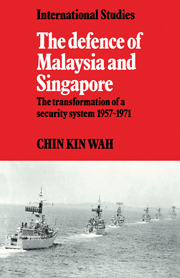Book contents
- Frontmatter
- Contents
- Preface
- Acknowledgements
- List of abbreviations
- Note on currency units
- 1 Introduction
- 2 Pre-treaty defence relations
- 3 Decolonisation and the institution of the defence agreement
- 4 The extension of AMDA
- 5 The external testing of AMDA
- 6 Towards a closing of ranks
- 7 The fractured axis
- 8 Britain weighs anchor
- 9 From AMDA to the five-power defence system
- 10 Conclusions
- Postscript on five-power arrangements
- Notes
- Bibliography
- Index
- Frontmatter
- Contents
- Preface
- Acknowledgements
- List of abbreviations
- Note on currency units
- 1 Introduction
- 2 Pre-treaty defence relations
- 3 Decolonisation and the institution of the defence agreement
- 4 The extension of AMDA
- 5 The external testing of AMDA
- 6 Towards a closing of ranks
- 7 The fractured axis
- 8 Britain weighs anchor
- 9 From AMDA to the five-power defence system
- 10 Conclusions
- Postscript on five-power arrangements
- Notes
- Bibliography
- Index
Summary
In the previous chapter it was observed that the mounting pressures of Confrontation had forced a closing of ranks between Singapore and Malaysia. To both, Confrontation had some positive unifying effects. The Tunku himself viewed Confrontation as ‘a blessing in disguise’. Much later, S. Rajaratnam, then Singapore's Minister for Culture, was to say that ‘in the early stages … [Confrontation had] helped to rally the diverse peoples of Malaysia together’. By the time Rajaratnam made this comment, in March 1965, the external threat was proving insufficient to hold together the Kuala Lumpur–Singapore axis.
The existence of an immediate external threat was not the raison d'être for AMDA's extension. Indeed, Confrontation, which engendered the crisis during which Canberra and Wellington extended their association with AMDA, was quite unexpected. AMDA's extension was rather an adjustment to the geographical dimensions of Malaysia, whose own raison d'être was the containment of Singapore's internal instability. While the inclusion of Singapore was intended to solve an internal security problem, it also opened up new areas of competition and conflict ranging from economic and financial issues to the fundamental question of Malaysia's national identity. And just as the extension of AMDA resulted from political unification, so the crisis of partnership between Malaysia and Singapore also affected defence co-operation among the allies. This crisis, which erupted despite the existing external threat, altered in the eyes of both Malaysia and Singapore, the priorities of various perceived threats and partly affected their later responses to Indonesia's abandonment of Confrontation.
- Type
- Chapter
- Information
- The Defence of Malaysia and SingaporeThe Transformation of a Security System 1957–1971, pp. 102 - 124Publisher: Cambridge University PressPrint publication year: 1982

